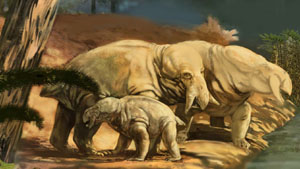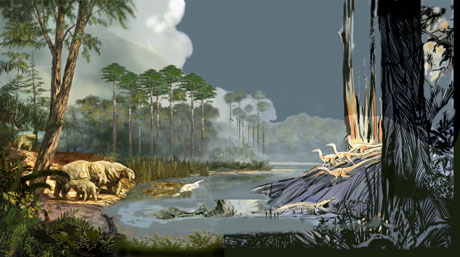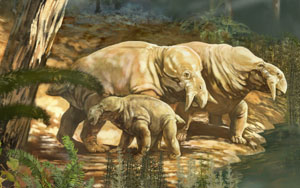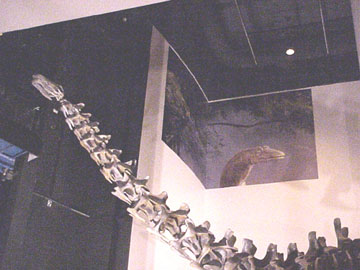How
I Make a Picture
by
Karen Carr |
5.
Spreading the Paint
With the approval of the
color roughs, I was able to sit down and start painting in
earnest. and these murals took a lot of time to paint.
|
Since
they are created digitally at full size, it was somewhat
easier (and safer) than using the traditional methods of
scaffolding and paint on walls. But, however you do a giant
mural, at some point you're faced with the need to sit down
and turn a rough design into a finished image. |
|

|
Placerias
painting in progress. |
All five images for the
Oklahoma halls represent something over 1500 hours of painting.
|
|
 |
Here's
another "work in progress" view. You'll notice
that there has to be a cooperation between the artist and
the museum designers: In the initial layout, I wanted the
crocodile-like phytosaur to be at the extreme right of the
water's edge. To accommodate the needs of the hall's design
and the mural's eventual presentation, though, I moved him
more toward the center of the water. |
Adding colors over the
original color sketch allows me to "build up" the final
image in glazes. This style of work is a preference I have, and it
is another hold-over from my oil painting. I think it gives my
paintings a sense of atmosphere, so clouds and light can become
"living" parts of the scene.
6.
Completing the Image
|
While
I was painting, I would send small portions of the murals to
the museum for their review, and to their designers and
production house to get their ideas and input.
|
 |
Once the mural was
complete, I sent the final file to the museum for their production.
The "back end" of the creative process, during which these
enormous digital paintings get turned into the giant color murals
shown on display, is really equal parts technology and art. My
paintings were transferred onto hundreds of huge vinyl panels, which
are applied to the museum walls like big sheets of wallpaper.
|
|
|

|
Here
is the first of the murals being installed in Oklahoma. This
photo shows just three of the mural panels in place: This
image has more than 60 such panels in all, and is more than
60 feet long. |
It was great to work with
the museum's partners on a project we could all participate in and
enjoy.
Next:
The finished image.
Reprinted with
permission from www.KarenCarr.com All
images © 2000 Karen Carr. All rights reserved. |



